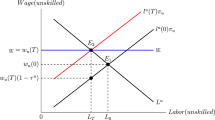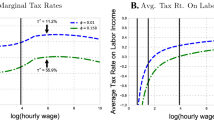Abstract
This paper characterizes the optimal redistributive tax schedule in a search–matching framework where (voluntary) nonparticipation and (involuntary) unemployment are endogenous and wages are determined by proportional bargaining à la Kalai. The optimal employment tax rate is given by an inverse elasticity rule. This rule depends on the global response of the employment rate, which depends not only on the participation (labor supply) responses, but also on the vacancy posting (labor demand) responses and on the product of these two responses. For plausible values of the parameters, our matching environment induces much lower employment tax rates than the usual competitive model with endogenous participation only. However, optimal employment tax rates are larger (in absolute value) when a given level of the global elasticity of employment is more due to search frictions and less due to participation responses.
Similar content being viewed by others
Notes
The employment tax is usually called participation tax in the literature that does not make the distinction between (involuntary) unemployment and (voluntary) non participation.
This condition guarantees that the decentralized economy is efficient in the absence of taxes, despite the presence of search–congestion externalities.
The Nash and the Kalai solution also differ whenever workers’ utility is nonlinear, so that utility is not one-to-one transferable between employers and employees.
Lehmann et al. (2011) also considered the competitive search equilibrium solution and showed it is equivalent to the one under Nash bargaining when the Hosios condition is met.
Intuitions about “bargaining power” and “fairness” might include the notion that if \(A\) could win a lot in a bargaining situation, he or she is “entitled” to more than if he or she could only, in the best of circumstances, win a little. Anyone who shares that intuition does not believe that “irrelevant” alternatives are irrelevant”, McDonald and Solow (1981, pp. 905–6). See also Laroque and Salanié (2004) in a related context.
In the published version, Lee and Saez (2012), the minimum wage and tax formula are simultaneously derived and the formula without minimum wage is not considered.
Risk neutrality is assumed for simplicity as standard in tax literature with wage bargaining.
Allowing an agent to work in any occupation which requires a skill below her type opens the possibility of monotonicity constraints and pooling. Choné and Laroque (2011) present sufficient conditions for the absence of pooling at the optimum in a pure extensive margin model.
In reality, the behavior of job-seekers can be imperfectly observed at some cost. This is taken into account in the literature on monitoring and sanctions (see e.g. Boone et al. 2007). Optimizing redistribution and the design of monitoring and sanction schemes is out of the scope of this paper. Assuming that unemployment and non participation can be perfectly distinguished at no cost is unrealistic. So, we adopt the alternative extreme assumption.
Where \(m_{a}^{-1}\left( .\right) \) denotes the reciprocal of function \(\theta \mapsto m_{a}\left( \theta \right) \), holding \(a\) constant.
If symmetry is required, the Kalai solution becomes the Egalitarian Solution discussed by L’Haridon et al. (2013) in the context of the search–matching literature.
The case where the employment tax decreases is symmetric as only first-order effects need to be considered.
As \(w_{a}-\tau _{a}=\gamma _{a}\left( a-\tau _{a}\right) \) from (7), we would have instead \(d e_{a}=\left[ \eta _{a}^{D}+\eta _{a}^{P}+\eta _{a}^{D}\cdot \eta _{a}^{P}\right] \cdot \frac{d\tau _{a}}{a-\tau _{a}}\cdot e_{a}\)
Appendix C of the companion working paper (Jacquet et al. 2012) considers the optimal tax problem when the government observes also the cost of searching \(\chi \). The optimal employment tax is then inversely related to the labor demand elasticity only. Intuitively, in such a case, the government can condition taxation on the cost of searching to enforce individuals’ participation decisions without distorting labor supply. The labor supply elasticity then does not appear in the optimal tax formula. However, the labor demand elasticity remains for two reasons. First, the government cannot influence the matching process. Second, the government has no tax instrument to influence the number of vacancies created on each labor market.
References
Alexander C (1992) The Kalai–Smorodinsky bargaining solution in wage negotiations. J Oper Res Soc 43(8):779–786
Allen S (1987) Taxation, redistribution, and the minimum wage: a theoretical analysis. Q J Econ 102(3):477–489
Beaudry P, Green D, Sand B (2010) How much is employment increased by cutting labor costs?. In: Estimating the elasticity of job creation. NBER working paper 15790. http://www.nber.org/papers/w15790
Boadway R, Cuff K, Marceau N (2003) Redistribution and employment policies with endogenous unemployment. J Public Econ 87(11):2407–2430
Boone J, Bovenberg L (2002) Optimal labour taxation and search. J Public Econ 85(1):53–97
Boone J, Fredriksson P, Holmlund B, van Ours JC (2007) Optimal unemployment insurance with monitoring and sanctions. Econ J 117(518):399–421
Bruce C, Clark J (2012) The impact of entitlements and equity on cooperative bargaining: an experiment. Econ Inq 50(4):867–879
Choné P, Laroque G (2005) Optimal incentives for labor force participation. J Public Econ 89(2–3):395–425
Choné P, Laroque G (2011) Optimal taxation in the extensive model. J Econ Theory 146(2):425–453
Diamond P (1980) Income taxation with fixed hours of work. J Public Econ 13(1):101–110
Diamond P (1982) Wage determination and efficiency in search equilibrium. Rev Econ Stud 49(2):217–227
Diamond P, Mirrlees J (1971) Optimal taxation and public production I: production efficiency and II: tax rules. Am Econ Rev 61:8–27, 261–278
Guesnerie R, Roberts K (1984) Effective policy tools and quantity controls. Econometrica 52(1):59–86
Guesnerie R, Roberts K (1987) Minimum wage legislation as a second best policy. Eur Econ Rev 31(1–2):490–498
Hosios A (1990) On the efficiency of matching and related models of search and unemployment. Rev Econ Stud 57(2):279–298
Hungerbühler M, Lehmann E (2009) On the optimality of a minimum wage: new insights from optimal tax theory. J Public Econ 93(3–4):464–481
Hungerbühler M, Lehmann E, Parmentier A, Van der Linden B (2006) Optimal redistributive taxation in a search equilibrium model. Rev Econ Stud 73(3):743–768
Immervoll H, Kleven H, Kreiner CT, Saez E (2007) Welfare reforms in European countries: a microsimulation analysis. Econ J 117(1):1–44
Jacquet L, Lehmann E, Van der Linden B (2012) Optimal redistributive taxation with both labor supply and labor demand responses. CESifo working paper 3779. http://www.cesifo-group.de/ifoHome/publications/working-papers/CESifoWP/CESifoWPdetails?wp_id=18026584
Kalai E (1977) Proportional solutions to bargaining situations: interpersonal utility comparisons. Econometrica 45(7):1623–1630
Kalai E, Smorodinsky M (1975) Other solutions to Nash’s bargaining problem. Econometrica 43(3):513–518
Kramarz F, Philippon T (2001) The impact of differential payroll tax subsidies on minimum wage employment. J Public Econ 82(1):115–146
Laroque G (2005) Income maintenance and labor force participation. Econometrica 73(2):341–376
Laroque G, Salanié B (2004) Salaire minimum et emploi en présence de négociations salariales. Ann Econ Stat 73:1–22
Lee D, Saez E (2008) Optimal minimum wage in competitive labor markets. NBER working paper 14320. http://www.nber.org/papers/w14320
Lee D, Saez E (2012) Optimal minimum wage policy in competitive labor markets. J Public Econ 96(9–10):739–749
Lehmann E, Parmentier A, Van der Linden B (2011) Optimal income taxation with endogenous participation and search unemployment. J Public Econ 95(11–12):1523–1537
L’Haridon O, Malherbet F, Perez-Duarte S (2013) Does bargaining matter in the small firm matching model? Labour Econ 21:42–58
McDonald I, Solow R (1981) Wage bargaining and employment. Am Econ Rev 71(5):896–908
Meghir C, Phillips D (2010) Labour supply and taxes. IZA discussion paper series 3405. http://www.ifs.org.uk/mirrleesReview/dimensions
Mirrlees J (1971) An exploration in the theory of optimum income taxation. Rev Econ Stud 38(2):175–208
Mortensen D, Pissarides C (1999) New developments in models of search in the labor market. In: Ashenfelter O, Card D (eds) Handbook of labor economics, vol 3B. Elsevier, Amsterdam
Nydegger R (1977) Independent utility scaling and the Nash bargaining model. Behav Sci 22(4):283–289
Nydegger R, Owen G (1974) Two-person bargaining: an experimental test of the Nash axioms. Int J Game Theory 3(4):239–249
Petrongolo B, Pissarides CA (2001) Looking into the black box: a survey of the matching function. J Econ Lit 39(2):390–431
Pissarides CA (2000) Equilibrium unemployment theory, 2nd edn. MIT Press, Cambridge
Rothstein J (2010) Is the EITC as good as an NIT? Conditional cash transfers and tax incidence. Am Econ J Econ Policy 2(1):177–208
Saez E (2002) Optimal income transfer programs: intensive versus extensive labor supply responses. Q J Econ 117(3):1039–1073
Saez E, Slemrod J, Giertz S (2012) The elasticity of taxable income with respect to marginal tax rates: a critical review. J Econ Lit 50(1):3–50
Stiglitz JE (1982) Self-selection and Pareto efficient taxation. J Public Econ 17(2):213–240
Acknowledgments
We thank the editor Marc Fleurbaey, two anonymous referees, Bas Jacobs, Guy Laroque, Jean-Marie Lozachmeur, Franck Malherbet, Louis Perrault, Laurent Simula, Alfons Weichenrieder and participants at the CPEG 2010 workshop at Queens’ University, the Nordic Workshop on Tax Policy and Public Economics in Copenhagen, the CESifo conference on Public Sector Economics, the workshop on “Taxation and Redistribution” at Linz, the 10th Journées Louis André Gérard Varet in Marseilles, the economic theory seminar at THEMA and the CESifo conference on “Taxation, Transfer and the Labour Market 2011” for helpful comments. Laurence Jacquet’s research was supported by a Marie Curie FP7 Integration Grant within the 7th European Union Framework Programme. Bruno Van der Linden has benefited from the financial supports of the Belgian French-speaking Community (convention ARC 09/14-019 on Geographical Mobility of Factors) and of the Belgian Program on Interuniversity Poles of Attraction (P6/07 Economic Policy and Finance in the Global Economy: Equilibrium Analysis and Social Evaluation).
Author information
Authors and Affiliations
Corresponding author
Appendices
Appendix 1: Link between the elasticity of the labor demand and the elasticity of the matching function
Let \(\mu _{a}\left( .\right) \) denote the elasticity of the matching function \(M_{a}\left( .,.\right) \) with respect to the mass of job-seekers \(U_{a}\). Because the matching function is increasing in both arguments and exhibits constant returns to scale, \(\mu _{a}\) depends only on the level of tightness and one has \(\mu _{a}\left( \theta \right) \in \left( 0,1\right) \) for all \(\theta \). From \(m_{a}\left( \theta \right) =M_{a}\left( 1,1/\theta \right) \), the elasticity of the probability of filling a vacancy to the tightness level (i.e. \(\left( \theta _{a}/m_{a}\right) \left( \partial m_{a}\left( \theta \right) /\partial \theta _{a}\right) \)) equals \(-\mu _{a}\left( \theta \right) \). Hence the elasticity of the reciprocal \(m_{a}^{-1}\left( .\right) \) equals \(-1/\mu _{a}\left( m_{a}^{-1}\left( .\right) \right) \). The log-differentiation of the \(L_{a}\) function (4) with respect to the firm’s surplus \(a-w_{a}\) gives:
which leads to the second equality in (5). The inequality holds because \(\mu _{a}\left( \theta \right) \in \left( 0,1\right) \).
Appendix 2: Proof of Proposition 1
The Lagrangian of the optimal tax problem is
where
The first-order condition with respect to \(b\) is:
Using (17) and (18) gives (19a). The first-order condition with respect to \(\tau _{a}\) writes \(0=\frac{\partial \mathcal L }{\partial \tau _{a}}\left( \tau _{a},b,\lambda \right) \). Using (3) and (5), this leads to:
Dividing both sides by \(\lambda h_{a}\ell _{a}=\lambda e_{a}\), using (17) and \(w_{a}-\tau _{a}=\gamma _{a}\left( a-\tau _{a}\right) \) [from (7)] gives (19b).
Rights and permissions
About this article
Cite this article
Jacquet, L., Lehmann, E. & Van der Linden, B. Optimal income taxation with Kalai wage bargaining and endogenous participation. Soc Choice Welf 42, 381–402 (2014). https://doi.org/10.1007/s00355-013-0736-0
Received:
Accepted:
Published:
Issue Date:
DOI: https://doi.org/10.1007/s00355-013-0736-0




